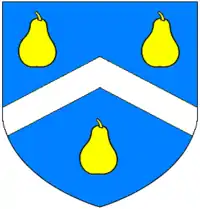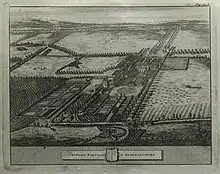Orchard Portman
Orchard Portman is a village and civil parish in Somerset, England, situated 2 miles (3.2 km) south of Taunton. The village has a population of 150.[1]
| Orchard Portman | |
|---|---|
 | |
 Orchard Portman Location within Somerset | |
| Population | 150 (2011)[1] |
| OS grid reference | ST245215 |
| Unitary authority | |
| Ceremonial county | |
| Region | |
| Country | England |
| Sovereign state | United Kingdom |
| Post town | TAUNTON |
| Postcode district | TA3 |
| Dialling code | 01823 |
| Police | Avon and Somerset |
| Fire | Devon and Somerset |
| Ambulance | South Western |
| UK Parliament | |
The parish includes the hamlet of Thurlbear and the nearby Thurlbear Wood and Quarrylands Site of Special Scientific Interest. St Thomas' church in Thurlbear is home to the heaviest complete set (cast together at the same time) of four church bells in the world.
History


The estate was known as Orceard and was given by King Æthelwulf of Wessex to Taunton's minster church in 854.[3]
The parish of Thurlbear was part of the North Curry Hundred, while Orchard Portman was part of the Taunton Deane Hundred.[4]
By 1135 the manor had passed to Elfric de Orchard and his descendants one of whom, Christina de Orchard, married Walter Portman. The village takes the second part of its name from the Portman family one of the earliest prominent members of which was Sir William Portman (died 1557), Chief Justice of the King’s Bench and lord of the manor. The estate was sold to the Commissioners of Crown Lands in 1944.[3]
Governance
The parish council has responsibility for local issues, including setting an annual precept (local rate) to cover the council’s operating costs and producing annual accounts for public scrutiny. The parish council evaluates local planning applications and works with the local police, district council officers, and neighbourhood watch groups on matters of crime, security, and traffic. The parish council's role also includes initiating projects for the maintenance and repair of parish facilities, as well as consulting with the district council on the maintenance, repair, and improvement of highways, drainage, footpaths, public transport, and street cleaning. Conservation matters (including trees and listed buildings) and environmental issues are also the responsibility of the council.
For local government purposes, since 1 April 2023, the village comes under the unitary authority of Somerset Council. Prior to this, it was part of the non-metropolitan district of Somerset West and Taunton (formed on 1 April 2019) and, before this, the district of Taunton Deane (established under the Local Government Act 1972). From 1894-1974, for local government purposes, Orchard Portman was part of Taunton Rural District.[5]
It is also part of the Taunton Deane county constituency represented in the House of Commons of the Parliament of the United Kingdom. It elects one Member of Parliament (MP) by the first past the post system of election.
Religious sites
The parish church of St Thomas at Thurlbear shows clear signs of the Norman church upon which later structures were built. Pevsner cites the Norman arcades and narrow aisles characteristic of that era and "never enlarged to satisfy later medieval taste." He dates the church to "hardly later than c. 1110."[6][7] The Churches Conservation Trust launched a programme of repairs at the church, with the Somerset County Council conducting an archaeological recording and survey in conjunction with these efforts.[8]
The Church of St Michael in Orchard Portman also has Norman origins with the chancel being rebuilt in the early 15th century. It formed part of the former Portman family mansion on the site. The Portman chapel was erected as the south aisle around 1450, demolished in 1844 and rebuilt again in 1910. The tower was rebuilt in 1521.[9][10] Dr Thomas Bond (1841–1901) a British physician considered by some to be the first offender profiler,[11][12][13] and best known for his association with the notorious Jack the Ripper murders of 1888, was buried in the churchyard.
Sport
Orchard Portman is the location of Taunton Racecourse which is used for thoroughbred horse racing, as well as a small cricket field.
References
- "Statistics for Wards, LSOAs and Parishes — SUMMARY Profiles" (Excel). Somerset Intelligence. Retrieved 4 January 2014.
- Collinson, History & Antiquities of Somerset, p.274, footnote
- Bush, Robin (1994). Somerset: The complete guide. Wimborne: The Dovecote Press Ltd. p. 163. ISBN 1-874336-26-1.
- "Somerset Hundreds". GENUKI. Retrieved 21 October 2011.
- "Taunton RD". A vision of Britain Through Time. University of Portsmouth. Retrieved 5 January 2014.
- Pevsner, Nikolaus (2003) [1958]. The Buildings of England, South and West Somerset. Penguin Books.
- Historic England. "Church of St Thomas (1176918)". National Heritage List for England. Retrieved 2 February 2009.
- Dunning, Robert; Croft, Robert (2007). Somerset Churches and Chapels, Building, Repair, and Restoration. Wellington, Somerset: Halsgrove Publishing. ISBN 978-1-84114-592-1.
- Dunning, Robert (2007). Somerset Churches and Chapels: Building Repair and Restoration. Halsgrove. p. 44. ISBN 978-1841145921.
- Historic England. "Church of St Michael (1060391)". National Heritage List for England. Retrieved 2 February 2009.
- 'Handbook of Criminal Investigation' by Tim Newburn, Tom Williamson, Alan Wright Published by Willan Publishing (2007) pg 493 ISBN 1-84392-187-1
- Serial Crime: Theoretical and Practical Issues in Behavioral Profiling By Wayne Petherick Published by Academic Press (2005) pg 1 ISBN 0-12-088512-3
- 'Psychology and Criminal Profiling' article on 'Forensic Biology'
